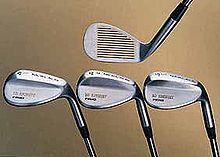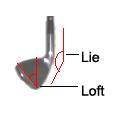Club types
Wood

Woods are long-distance clubs, meant to drive the ball a great distance down the fairway towards the hole. They generally have a large head and a long shaft for maximum club speed. Historically, woods were made from persimmon wood, although some manufacturers—notably Ping—developed laminated woods. In 1979, TaylorMade Golf introduced the first wood made of steel. Even more recently, manufacturers have started using materials such as carbon fiber, titanium, or scandium. Although most 'woods' in golf are constructed from various metals, the term 'woods' persists to characterize their general shape and intended use on the golf course. Contemporary woods commonly feature a graphite shaft paired with a predominantly hollow head made of titanium, composite materials, or steel. This design emphasizes light weight, enabling faster club-head speeds. Woods, being the longest and most powerful clubs, typically consist of three to four options in a set. They are primarily utilized from the tee box and, on longer holes, may be employed for the second or even third shot. The largest wood, often referred to as the driver or one wood, is frequently crafted from hollow titanium and incorporates feather-light shafts. The length of the woods has been increasing in recent decades, and a typical driver with a graphite shaft is now 45.5 inches (1,160 mm) long. The woods may also have very large heads, up to 460 cm3 (28 cu in) in volume (the maximum allowed by the USGA in sanctioned events; drivers with even larger club-head volumes are available for long-drive competitions and informal games). The shafts range from senior to extra-stiff depending upon each player’s preference. [2]
Iron

Irons are clubs with a solid, all-metal head featuring a flat angled face, and a shorter shaft and more upright lie angle than a wood, for ease of access. Irons are designed for a variety of shots from all over the course, from the tee box on short or dog-legged holes, to the fairway or rough on approach to the green, to tricky situations like punching through or lobbing over trees, getting out of hazards, or hitting from tight lies requiring a compact swing. Most of the irons have a number from 1 to 9 (the numbers in most common use are from 3 to 9), corresponding to their relative loft angle within a matched set. Irons are typically grouped according to their intended distance (which also roughly corresponds to their shaft length and thus their difficulty to hit the ball); in the numbered irons, there are long irons (2–4), medium irons (5–7), and short irons (8–9), with progressively higher loft angles, shorter shafts, and heavier club heads.
As with woods, ’irons’ get their name because they were originally made from forged iron. Modern irons are investment-cast out of steel alloys, which allows for better-engineered ‘cavity-back’ designs that have lower centers of mass and higher moments of inertia, making the club easier to hit and giving better distance than older forged ’muscle-back’ designs. Forged irons with less perimeter weighting are still seen, especially in sets targeting low-handicap and scratch golfers, because this less forgiving design allows a skilled golfer to intentionally hit a curved shot (a ’fade’ or ’draw’), to follow the contour of the fairway or ’bend’ a shot around an obstacle.
Wedge

Wedges are a subclass of irons with greater loft than the numbered irons (generally starting at 47°–48° of loft, above the 9-irons of 44°–45°), and other features such as high-mass club heads and wide soles that allow for easier use in tricky lies. Wedges are used for a variety of short-distance, high-altitude, high-accuracy ’utility’ shots, such as hitting the ball onto the green ("approach" shots), placing the ball accurately on the fairway for a better shot at the green ("lay-up" shots), or hitting the ball out of hazards or rough onto the green (chipping). There are five main types of wedges, with lofts ranging from 45° to 64°: pitching wedge (PW, 48–50°), gap wedge (GW, also "approach", "attack", "utility", or "dual" wedge, typically 52–54°), sand wedge (SW, 55–56°), lob wedge (LW, 58°–60°), and ultra lob wedge (sometimes called the "flop wedge" or FW, 64°–68°).
Hybrid

Hybrids are a cross between a wood and an iron, giving these clubs the wood's long distance and higher launch, with the iron's familiar swing. The club head of a hybrid has a wood-inspired, slightly convex face, and is typically hollow like modern metal woods to allow for high impulse on impact and faster swing speeds. The head is usually smaller than true woods, however, not extending as far back from the face, and the lie and shaft length are similar to an iron giving similar swing mechanics. These clubs generally replace low-numbered irons in a standard set (between 2 and 5, most commonly 3–4), which are typically the hardest clubs in a player's bag to hit well.[ citation needed ] By doing so they also generally make higher-lofted woods redundant as well. However, some manufacturers produce "iron replacement" sets that use hybrid designs to replace an entire set of traditional irons, from 3 to pitching wedge. Sets designed for less muscular players commonly feature a combination of high-lofted woods (up to 7-wood) and hybrids to replace the 5, 6 and 7-irons, allowing these players to achieve greater carry distances with slower swings.
Putter

Putters are a special class of clubs with a loft not exceeding ten degrees, designed primarily to roll the ball along the grass, generally from a point on the putting green toward the hole. Contrary to popular belief, putters do have a loft (often 5° from truly perpendicular at impact) that helps to lift the ball from any indentation it has made. Newer putters also include grooves on the face to promote roll rather than a skid off the impact. This increases rolling distance and reduces bouncing over the turf. Putters are the only class of club allowed to have certain features, such as two striking faces, non-circular grip cross-sections, bent shafts or hosels, and appendages designed primarily to aid players' aim.
Chipper
Present in some golfers' bags is the chipper, a club designed to feel like a putter but with a more lofted face, used with a putting motion to lift the ball out of the higher grass of the rough and fringe and drop it on the green, where it will then roll like a putt. This club replaces the use of a high-lofted iron to make the same shot, and allows the player to make the shot from a stance and with a motion nearly identical to a putt, which is more difficult with a lofted iron due to a difference in lie angle.
Most chippers have a loft greater than 10 degrees, which is the maximum loft permitted by the Rules of Golf for a club to be classed as a putter, so these clubs are actually classed as irons. To be legal for sanctioned play, a chipper cannot have any feature that is defined in the rules as allowable only on putters, e.g. two striking faces or a flat-topped "putter grip". This disqualifies many chipper designs, but there are some USGA-conforming chippers, and non-conforming designs can still be used for informal play.












